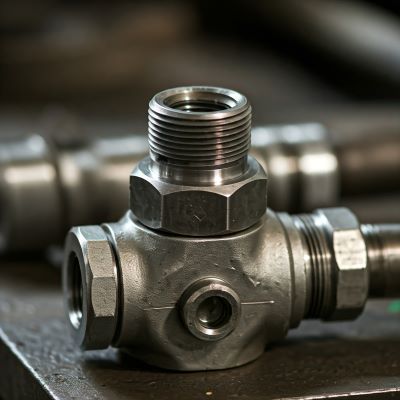Hydraulic pump fittings are essential components in any hydraulic system, ensuring a secure and efficient connection between the pump and its associated components. Choosing the right fittings can significantly impact the performance, reliability, and longevity of your system.
In this blog post, we’ll delve into the key considerations for selecting hydraulic pump fittings, explore different types and their uses, and provide tips for installation, maintenance, and troubleshooting.
Understanding Hydraulic Pump Fittings
Hydraulic pump fittings act as connectors, creating a seal between the pump and hoses or other components. They are designed to withstand high pressures and temperatures, preventing leaks that can lead to system failures and costly downtime.
Types of Hydraulic Fittings: From Threaded to Flanged Connections
There are various types of hydraulic fittings, each suited for different applications:
➡️ Threaded fittings: The most common type, using threads to connect components.
➡️ Flanged fittings: Used for larger-diameter hoses and pipes, requiring a flange for connection.
➡️ Quick-connect fittings: Provide a quick and easy way to connect and disconnect components.
➡️ Swivel fittings: Allow for flexibility and rotation in the system.
➡️ Specialty fittings: Designed for specific applications, such as high-pressure or high-temperature environments.
How Hydraulic Pump Fittings Ensure a Secure, Leak-Free System
Hydraulic fittings are designed with precision to create a tight seal between components. This prevents leaks that can cause system failures, loss of pressure, and contamination.
Common Materials Used in Hydraulic Fittings: Steel, Brass, and More
The material used for hydraulic fittings depends on the specific requirements of the application. Common materials include:
➡️ Steel: Suitable for most uses, it is strong and long-lasting.
➡️ Brass: Corrosion-resistant, often used in marine and industrial environments.
➡️ Stainless steel: Extremely resistant to oxidation and corrosion.
➡️ Aluminum: Perfect for mobile applications because it is lightweight and resistant to corrosion.
Key Factors to Consider When Selecting Hydraulic Pump Fittings
Compatibility: Matching Fittings with Your Pump and Hose Specifications
Ensure that the fittings you select are compatible with your pump and hoses. Check the specifications for thread size, pressure rating, and material compatibility.
Pressure Ratings: Ensuring Fittings Can Withstand System Demands
Choose fittings with a pressure rating that exceeds the maximum operating pressure of your system to prevent failures and leaks.
Temperature Resistance: Choosing Fittings for Extreme Conditions
If your system operates in extreme temperatures, select fittings that can withstand those conditions without compromising their integrity.
Corrosion Resistance: Protecting Your System in Harsh Environments
In corrosive environments, opt for fittings made from materials that are resistant to corrosion, such as stainless steel or brass.
Size and Thread Type: Getting the Right Fit for Maximum Efficiency
Select fittings with the correct size and thread type to ensure a proper fit and prevent leaks.
Types of Hydraulic Fittings and Their Uses
Overview of Reusable vs. Permanent Hydraulic Fittings
➡️ Reusable fittings: Can be disconnected and reconnected multiple times.
➡️ Permanent fittings: Designed for a single connection and cannot be reused.
Straight, Elbow, and Tee Fittings: When to Use Each Type
➡️ Straight fittings: Used for connecting components in a straight line.
➡️ Elbow fittings: Used to alter the flow’s direction.
➡️ Tee fittings: Used to create a branch in the system.
Swivel Fittings for Flexibility in Tight Spaces
Swivel fittings allow for flexibility and rotation, making them ideal for tight spaces or applications where the hose needs to move.
Specialty Fittings for High-Pressure or High-Temperature Applications
Specialty fittings are designed to meet the specific requirements of high-pressure or high-temperature applications.
Tips for Ensuring Proper Installation of Hydraulic Fittings
Preparing the Fitting and Hose for Installation: Best Practices
➡️ Clean the fitting and hose to remove any debris or contaminants.
➡️ Lubricate the threads with hydraulic sealant or PTFE tape.
Avoiding Common Installation Mistakes That Lead to Leaks
➡️ Overtightening: Avoid excessive torque, as it can damage the fitting or hose.
➡️ Cross-threading: Ensure proper alignment of the threads.
➡️ Damaged fittings: Replace any damaged or worn fittings.
Using the Right Tools: How to Tighten and Secure Fittings Properly
Use the appropriate wrench or socket to tighten the fittings to the specified torque.
Testing Your System: Ensuring a Leak-Free Hydraulic Connection
After installation, test the system for leaks by operating it under pressure and inspecting all connections.
Maintenance and Troubleshooting for Hydraulic Pump Fittings
Regular Inspections: How to Spot Early Signs of Wear and Tear
➡️ Check for leaks, cracks, or corrosion.
➡️ Inspect the condition of the threads and seals.
Cleaning and Lubrication Tips for Extending Fitting Lifespan
➡️ Clean fittings regularly to remove dirt and contaminants.
➡️ Apply a thin layer of hydraulic sealant or PTFE tape to the threads during reassembly.
Quick Fixes for Common Fitting Issues: Leaks, Cracks, and Loose Connections
➡️ Leaks: Tighten the fitting or replace the seal.
➡️ Cracks: Replace the damaged fitting.
➡️ Loose connections: Retighten the fitting.
When to Replace Fittings: Recognizing the Signs of Deterioration
➡️ Replace fittings that are severely damaged, cracked, or corroded.
➡️ If a fitting is frequently leaking, it may be time for replacement.
Conclusion
Selecting the right hydraulic pump fittings is crucial for ensuring the efficient and reliable operation of your hydraulic system.
By understanding the key factors to consider, exploring different types of fittings, and following proper installation and maintenance practices, you can minimize downtime and maximize the performance of your system.
Post time: Oct-19-2024


